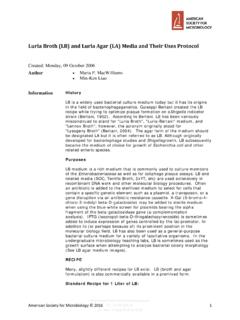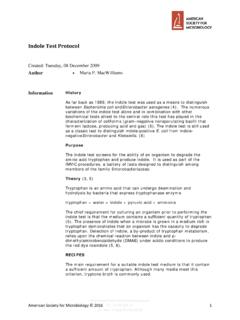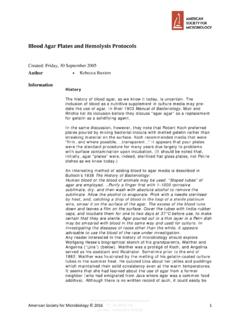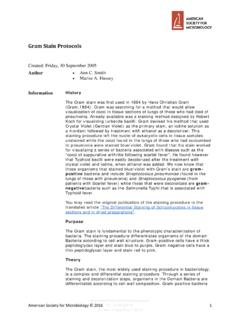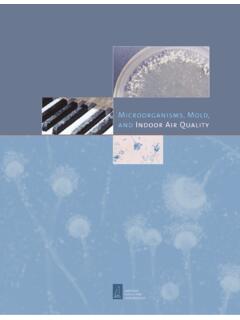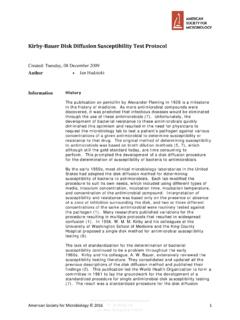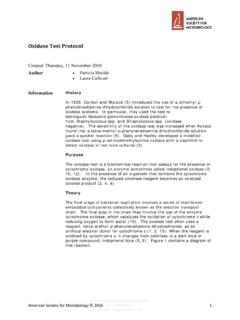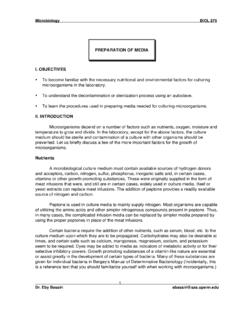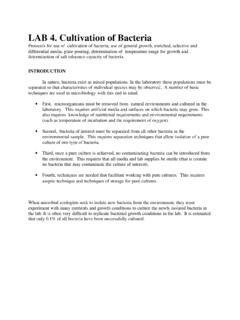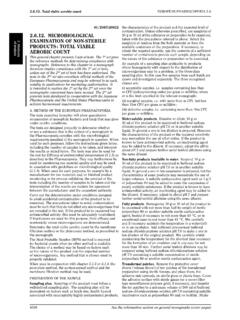Transcription of Urease Test Protocol
1 Downloaded from byIP: : Mon, 12 Aug 2019 17:30:19 American Society for Microbiology 2016 1 Urease Test Protocol | | Created: Thursday, 11 November 2010 Author Benita Brink Information History The alkaline fermentation of urine (urea) with the resultant production of ammonia was hypothesized to occur due to the action of microorganisms by Reoch in 1875 (6). Many forms of urea-degrading bacteria were subsequently isolated and their Urease activity studied (3). Urease activity is considered to be a major criterion for the identification of Proteus species and allows for Proteus to be distinguished from non-lactose-fermenting members of the Enterobacteriaceae (1).
2 A chemically defined medium that was shown to be differential for Proteus species was formulated by Stuart (7). In this medium, Proteus are capable of using urea as a sole nitrogen source and produce sufficient quantities of ammonia to overcome the high buffering capacity of the medium resulting in a color change from yellow to bright pink (fuschia). Christensen later formulated a medium that would allow growth of other members of theEnterobacteriaceae that cannot utilize the by-product of urea hydrolysis (ammonia) as a sole nitrogen source for growth (2). This medium also has a decreased buffering capacity allowing for the detection of smaller quantities of alkali produced from the degradation of urea.
3 Thus organisms with a slight or delayed Urease activity can be detected with Christensen s urea agar. Purpose The Urease test identifies those organisms that are capable of hydrolyzing urea to produce ammonia and carbon dioxide. It is primarily used to distinguish Urease -positive Proteeae from otherEnterobacteriaceae. Theory (5, 8) Urease is a constitutively expressed enzyme that hydrolyzes urea to carbon dioxide and ammonia. (NH2)2CO + H2O CO2 + 2NH3 Urease test media contain 2% urea and phenol red as a pH indicator. An increase in pH due to the production of ammonia results in a color change from yellow (pH ) to bright pink (pH ).
4 Urea broth (Stuart s urea broth) is a highly buffered medium requiring large quantities of Downloaded from byIP: : Mon, 12 Aug 2019 17:30:19 American Society for Microbiology 2016 2 ammonia to raise the pH above resulting in a color change. This medium provides all essential nutrients forProteus, for which it is differential. Urea agar (Christensen s urea agar) has a reduced buffer content and contains peptones and glucose. This medium supports the growth of many enterobacteria allowing for the observation of Urease activity. RECIPE Two media types are commonly used to detect Urease activity.
5 Christensen s urea agar is used to detect Urease activity in a variety of microorganisms. Stuart s urea broth is used primarily for the differentiation of Proteus species. Both media types are available commercially as prepared tubes or as a powder. Christensen s Urea Agar (2, 4, 5) Ingredient Amount peptone 1 g Dextrose 1 g Sodium chloride 5 g Potassium phosphate, monobasic 2 g Urea 20 g Phenol red g Agar 15 to 20 g To prepare the urea base, dissolve the first six ingredients in 100 ml of distilled water and filter sterilize ( pore size). Suspend the agar in 900 ml of distilled water, boil to dissolve completely, and autoclave at 121oC and 15 psi for 15 minutes.
6 Cool the agar to 50 to 55oC. Aseptically add 100 ml of filter-sterilized urea base to the cooled agar solution and mix thoroughly. Distribute 4 to 5 ml per sterile tube (13 x 100 mm) and slant the tubes during cooling until solidified. It is desirable to have a long slant and short butt. Prepared media will have a yellow-orange color. Store the prepared media in the refrigerator at 4 to 8oC until needed. Once prepared, do not reheat the medium as the urea will decompose. Stuart s Urea Broth (4, 5, 7) Ingredient Amount Yeast extract g Potassium phosphate, monobasic g Potassium phosphate, dibasic g Urea 20 g Phenol red g Dissolve all ingredients in 1 liter of distilled water and filter sterilize Downloaded from byIP: : Mon, 12 Aug 2019 17:30:19 American Society for Microbiology 2016 3 ( pore size).
7 Distribute 3 ml of prepared broth per sterile tube (13 x 100 mm). Prepared media will have a yellow-orange color. Store the prepared broth in the refrigerator at 4 to 8oC until needed. Do not heat the medium as the urea will decompose. Protocol Christensen s Urea Agar (4, 5) Use a heavy inoculum from an 18- to 24-hour pure culture to streak the entire slant surface. Do not stab the butt as it will serve as a color control (Fig. 1c). Incubate tubes with loosened caps at 35oC. Observe the slant for a color change at 6 hours, 24 hours, and every day for up to 6 days.
8 Urease production is indicated by a bright pink (fuchsia) color on the slant that may extend into the butt. Note that any degree of pink is considered a positive reaction. Prolonged incubation may result in a false-positive test due to hydrolysis of proteins in the medium. To eliminate protein hydrolysis as the cause of a positive test, a control medium lacking urea should be used. Rapidly Urease -positive Proteeae (Proteus spp., Morganella morganii, and some Providencia stuartiistrains) will produce a strong positive reaction within 1 to 6 hours of incubation. Delayed-positive organisms ( , Klebsiella or Enterobacter) will typically produce a weak positive reaction on the slant after 6 hours, but the reaction will intensify and spread to the butt on prolonged incubation (up to 6 days).
9 The culture medium will remain a yellowish color if the organism is Urease negative (Fig. 1). Downloaded from byIP: : Mon, 12 Aug 2019 17:30:19 American Society for Microbiology 2016 4 a b c d FIG. 1. Urea agar test results. Urea agar slants were inoculated as follows: (a) uninoculated, (b)Proteus mirabilis (rapidly Urease positive), (c) Klebsiella pneumoniae (delayed Urease positive), (d)Escherichia coli ( Urease negative). All samples were incubated at 37oC for 16 hours. Stuart s Urea Broth (4, 5) Use a heavy inoculum from an 18- to 24-hour pure culture to inoculate the broth.
10 Shake the tube gently to suspend the bacteria. Incubate tubes with loosened caps at 35oC. Observe the broth for a color change at 8, 12, 24, and 48 hours. Urease production is indicated by a bright pink (fuchsia) color throughout the broth. Rapidly Urease -positive Proteeae (Proteus spp., Morganella morganii, and some Providencia stuartiistrains) for which this medium is differential, will produce a strong positive reaction as early as 8 hours, but always within 48 hours of incubation. Delayed-positive organisms ( , Enterobacter) will not produce a positive reaction due to the high buffering capacity of this medium.

